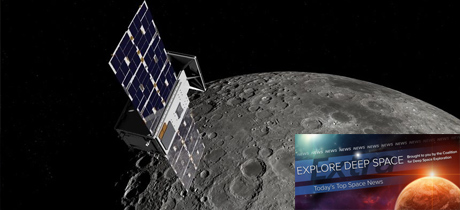In Today’s Deep Space Extra… NASA and its contractor team successfully retest SLS core stage engines on their way to an Artemis I Wet Dress Rehearsal. Russia offers European astronauts an “independent” human launch capability. Astronomers are eager for James Webb Space Telescope observations of Sagittarius A, the black hole at the center of the Milky Way.
Human Space Exploration
NASA successfully retests Moon rocket core stage engines after fault
Coalition Member in the News – Aerojet Rocketdyne
Space.com (2/21): All four of NASA’s Space Launch System (SLS) core stage RS-25 rocket engines have demonstrated expected performance following a recent evaluation, after a faulty controller was discovered on one of the engines. The controller elements of the Aerojet Rocketdyne rocket engines communicate with other SLS elements to provide precision control and internal health diagnostics. The demonstration is helping to clear the way for a Wet Dress Rehearsal ahead of the Artemis I test flight. The Wet Dress Rehearsal in which the Artemis I SLS and Orion spacecraft will roll out to its Kennedy Space Center (KSC) launch pad for a simulation of all but the final seconds of an actual countdown and liftoff, is planned for March.
Russia responds to European astronauts: We’ll give you independent spaceflight
Arstechnica.com (2/21): Dmitry Rogozin, head of Roscosmos, is calling on European policymakers and astronauts to make Soyuz spacecraft and Russian launch capabilities from French Guiana their human space launch option. The suggestion comes after European astronauts called for an independent launch capability for Europe, saying they should not depend on others’ spacecraft to launch to space. Russia is emphasizing the cost savings. Others are questioning the actual independence for Europe of such a strategy.
Space Science
NASA and HeroX are crowdsourcing the search for life on Mars
Universetoday.com (2/22): NASA has joined with HeroX and DrivenData to announce a crowdsource initiative to develop a spectrographic technology to help detect biological activity in Martian samples returned to Earth. The “Mars Spectrometry: Detect Evidence for Past Life” challenge is offering a total of $30,000 in prize money to first, second, and third place finishers. Individuals and teams whose members are at least 18 years old and from countries not under U.S. sanction are eligible to submit proposals. The deadline for submissions is April 18.
James Webb Space Telescope will study Milky Way’s flaring supermassive black hole
Space.com (2/21): Once fully commissioned in the months ahead, the James Webb Space Telescope’s (JWST) science team will work with the network of ground-based Event Horizon Telescope (EHT) radio observatory array to image Sagittarius A, the large flickering black hole at the center of the Milky Way galaxy. It was in 2019 that the Event Horizon Network captured the first image of a blackhole, which is designated M87. The JWST’s infrared optics are expected to provide new insight into the mysterious flickering nature of Sagittarius A.
Other News
Northrop Grumman to launch new satellite-servicing mission in 2024
Coalition Member in the News – Northrop Grumman
SpaceNews.com (2/21): SpaceLogistics, a satellite servicing company owned by Northrop Grumman, announced on Monday that it plans to launch a new servicing spacecraft called the Mission Robotic Vehicle in 2024. Leveraged from the design and accomplishments of two SpaceLogistic Mission Extension Vehicles, the new robotic vehicle will be equipped with a robotic arm and three propulsion jet packs. The jet packs, equipped with their own thrusters, are to be installed on three large satellites in order to extend their operational lives by six years.
CAPSTONE lunar cubesat mission to launch this spring
SpaceNews.com (2/22): The Cislunar Autonomous Positioning System Technology Operations and Navigation Experiment (CAPSTONE) spacecraft will test operations in the near-rectilinear halo orbit (NRHO) around the Moon. The orbit will be used by Artemis missions, including the lunar Gateway. NASA selected Colorado-based Advanced Space to develop the mission in 2019. It will launch on a Rocket Lab Electron rocket using a version of their Photon satellite bus. CAPSTONE will not go directly to the Moon but instead follow a ballistic lunar transfer that will take it out about 1 million miles before returning into lunar orbit.
China claims rocket stage destined for lunar impact is not from its 2014 Moon mission
SpaceNews.com (2/21): Earlier this year, astronomers said debris from a Falcon 9 rocket was on a trajectory to collide with the Moon March 4. A statement from NASA’s Jet Propulsion Laboratory’s (JPL) Center for Near-Earth Object Studies later said the object is likely the Chinese Chang’e 5-T1 booster launched in 2014, instead. Independent analysis by students at the University of Arizona also claimed the object’s identity as most likely belonging to China’s mission. However, China’s Ministry of Foreign Affairs claims the debris set to impact the Moon in March does not originate from the 2014 Chang’e-5 T1 mission, a claim backed by observations from the Space Force’s 18th Space Control Squadron.

